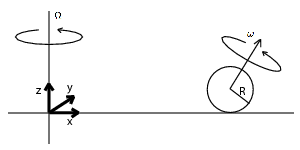Physics 105 Problem Set 7
Due: Thursday, November 15, 2007, by 4:30 pm in 208 Jadwin.
Reading for this week K&K Chapter 9
- Background information (some
of which you have read already.)
- K&K pp. 27-35
- K&K pp. 80-86, 101-103 (these properties of gravity are
very important, and we will probably not go over them in lecture.)
- K&K Examples 4.5, 4.12, and section 4.9
- K&K 9 (skim examples 9.3)
- Optional.
- Knight Ch. 12
- As always, it is a good idea to warm up by doing
problems in 103 Learning Guide.
Problems to turn in:
Problem 7.1 Warm-ups.
-
- a) Show that the momentum of each particle in the center-of-mass frame
of a two-body system is
p*=+-µv,
where µ is the reduced
mass and v is the relative velocity.
Parts b) and c) refer to circular orbits. Do them using
simple considerations of uniform circular motion, not
the heavy
artillery of K&K 9!
-
- b) For a circular orbit of small mass m about large mass
M, find
the relation between the kinetic and potential energy for this gravitational
interaction.
- c) Prove Kepler's third law for the case of circular orbits and the
gravitational force:
T2 = kR3,
where T and R are
the period and radius of an orbit, again for M>>m.
Find k for the Solar System.
Problem 7.2 K&K 9.5
Some hints:
-
- -- Note that from the force law given, you can see that the relaxed
length of this spring is zero.
- -- In part b), the radial impulse is given in addition to the circular
motion of part a).
- -- In part b), make a useful energy diagram,
i.e., one that actually illustrates the solution to part c).
Problem 7.3 Learning Guide 7, problem IV.
Problem 7.4 K&K 9.8
Problem 7.5 K&K 9.9
Problem 7.6
As shown below, a uniform ball of radius R rolls without slipping on a turn
table that spins at angular frequency Ω along the
positive z direction. Demonstrate that the ball follows a circular
orbit (not necessarily centered on the axis of rotation of the turn table)
given by dv/dt= Ω′ x
v where v is measured
in the lab frame. How does this equation produce a circular orbit?
What is Ω′ ?
Note that although this problem is about orbits, the only role of gravity is
to keep the ball on the turn table so that it can roll without slipping.
You may want to start by finding an expression for the velocity of the ball
in the lab frame. If you give a complete solution (ball positions, linear
velocity, and angular velocity direction) for one of the possible orbits
you will earn 5 points of extra credit.


